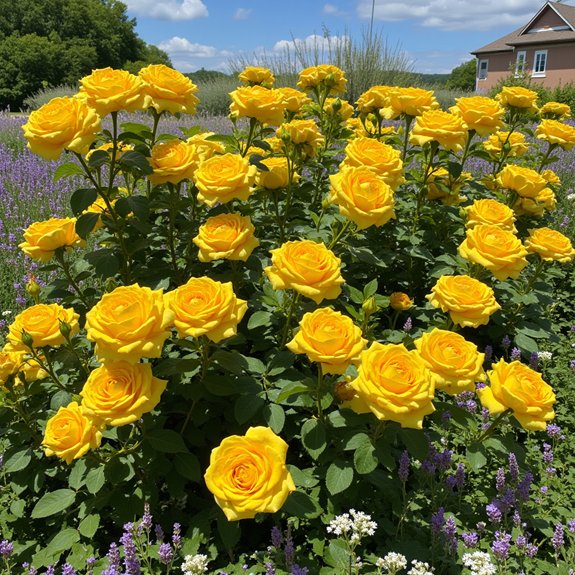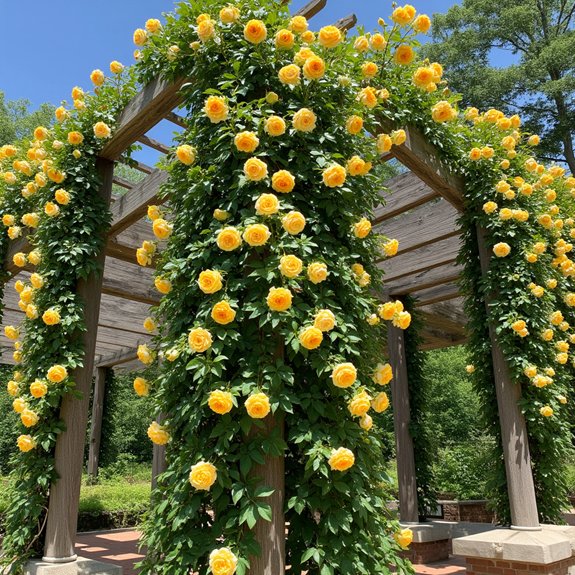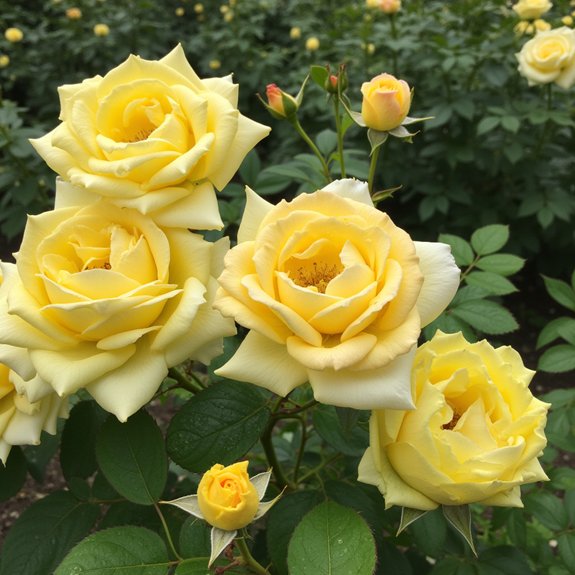Yellow roses transform ordinary garden spaces into vibrant showcases that catch attention from every angle. These cheerful blooms offer more than just visual appeal, symbolizing friendship while providing practical benefits like deer resistance and extended bloom periods. Garden enthusiasts discover that yellow varieties adapt to diverse growing conditions, from compact container gardens measuring just 2-3 feet to expansive climbing displays reaching 12-15 feet. However, selecting the right yellow rose requires understanding specific varieties, their unique care requirements, and strategic placement considerations that determine long-term success.
Contents
- 1 Why Yellow Roses Bring Joy to Any Garden Space
- 2 Top Yellow Rose Varieties for Different Garden Sizes
- 3 Climbing Yellow Roses That Create Stunning Vertical Displays
- 4 Compact Yellow Roses Perfect for Small Gardens and Containers
- 5 Fragrant Yellow Rose Varieties That Delight the Senses
- 6 Yellow Roses That Thrive in Challenging Climate Conditions
- 7 Essential Care Tips for Growing Healthy Yellow Roses
- 8 Best Planting Times and Location Considerations for Yellow Roses
Why Yellow Roses Bring Joy to Any Garden Space

Luminosity transforms ordinary garden spaces into vibrant sanctuaries, and yellow roses deliver this transformation with unmatched brilliance. Yellow rose symbolism represents friendship, warmth, and new beginnings, making these blooms perfect conversation starters for visiting neighbors. Garden color psychology reveals that yellow stimulates mental clarity while reducing stress levels in outdoor environments.
These cheerful roses create focal points that draw attention from 20-30 feet away, establishing natural gathering spots for family activities. The bright petals reflect sunlight during morning hours, extending perceived daylight in shadowed garden areas. Yellow varieties like Julia Child or Sunsprite maintain their vibrant color intensity throughout summer months.
Top Yellow Rose Varieties for Different Garden Sizes
Garden dimensions directly influence rose selection, with compact Julia Child varieties thriving in 2-3 foot spaces while towering Graham Thomas climbers demand 10-12 feet of vertical room. Small gardens benefit from Rainbow Sunblaze miniatures, reaching just 2-4 feet, perfect for containers and borders. Medium spaces accommodate Charlotte roses at 3-4 feet, ideal for yellow rose arrangements with their cutting-friendly stems. Large gardens showcase Yellow Lady Banks’ impressive 15-20 foot spread, creating dramatic backdrops that enhance yellow rose symbolism of friendship and joy. Consider Eternal Flame for middle-ground plantings, offering 4-5 foot height with fragrant lemon-scented blooms for balanced garden proportions.
Climbing Yellow Roses That Create Stunning Vertical Displays

Vertical garden transformations reach their peak when climbing yellow roses ascend trellises, arbors, and pergolas with dramatic flair. Graham Thomas towers impressively at 10-12 feet, producing honey-yellow blooms that create stunning backdrops. Yellow Lady Banks climbs even higher, reaching 15-20 feet with small, creamy double flowers that cascade beautifully. Teasing Georgia matches Graham Thomas’s height with magnificent ruffled petals.
Proper climbing techniques involve training canes horizontally along supports, encouraging more blooms along each branch. Vertical gardening with these varieties requires sturdy structures capable of supporting mature growth. Install supports before planting, spacing canes 18 inches apart for ideal air circulation and sunlight penetration.
Compact Yellow Roses Perfect for Small Gardens and Containers
While towering climbers command attention through sheer scale, compact yellow roses deliver equal beauty within confined spaces through careful breeding and thoughtful selection. Julia Child reaches just 2-3 feet, making it perfect for patios. Rainbow Sunblaze represents excellent miniature rose varieties, growing 2-4 feet with bright yellow petals outlined in crimson red. These compact beauties thrive in containers with proper drainage and 6-8 hours of sunlight. Essential container gardening tips include deep watering schedules, regular deadheading, and choosing pots at least 18 inches wide. Charlotte and Tupelo Honey offer fragrant 3-4 foot options for small garden borders.
Fragrant Yellow Rose Varieties That Delight the Senses

Fragrance transforms any garden experience from visual appreciation into a multi-sensory journey that engages visitors on deeper levels. Golden Celebration produces globular double flowers with a distinctive strawberry wine aroma, reaching 4.5-5 feet tall. The Poet’s Wife offers deep lemon scent from creamy yellow blooms that fade beautifully from daffodil to buttercream. Eternal Flame delivers fresh lemon fragrance alongside bright yellow petals. These fragrant rose characteristics create memorable sensory garden experiences, drawing visitors closer to appreciate both visual beauty and aromatic qualities that standard roses cannot provide.
Yellow Roses That Thrive in Challenging Climate Conditions
Gardeners in extreme climates often struggle to find rose varieties that can withstand scorching heat, humidity, or unpredictable weather patterns. SunbeltⓇ South Africa offers exceptional climate adaptability, thriving in zones 6-10 while handling both high temperatures and rainy seasons. This hardy variety produces rich golden blooms from spring through frost, making it ideal for challenging conditions.
Tupelo Honey provides remarkable drought resistance, flourishing in hot, humid climates where other yellows fail. Growing 3-4 feet tall, it delivers excellent repeat blooms with honeysuckle fragrance. Both varieties demonstrate superior resilience, ensuring beautiful yellow roses even in demanding environments.
Essential Care Tips for Growing Healthy Yellow Roses
Most yellow rose varieties require consistent attention to soil preparation, watering schedules, and seasonal maintenance to reach their full potential. Proper pruning techniques involve removing dead canes in late winter, cutting at 45-degree angles above outward-facing buds. Regular fertilization schedules should include balanced 10-10-10 fertilizer monthly during growing season, plus organic compost twice yearly.
Water deeply once weekly, providing 1-2 inches at soil level rather than overhead spraying. Monitor for black spot disease, especially on susceptible varieties like Mellow Yellow. Mulch around base with 2-3 inches of organic material to retain moisture and suppress weeds effectively.
Best Planting Times and Location Considerations for Yellow Roses
When selecting the perfect spot for yellow roses, timing becomes as vital as location since these perennials establish stronger root systems during specific seasons. Spring and fall offer ideal planting windows when temperatures remain moderate, allowing roses to adapt without extreme weather stress.
Location factors greatly impact rose success. These beauties require 6-8 hours of direct sunlight daily, with morning sun being particularly important for drying dew and preventing disease. Proper planting techniques include choosing well-draining soil and avoiding low-lying areas where water collects, which can lead to root rot and other complications.
